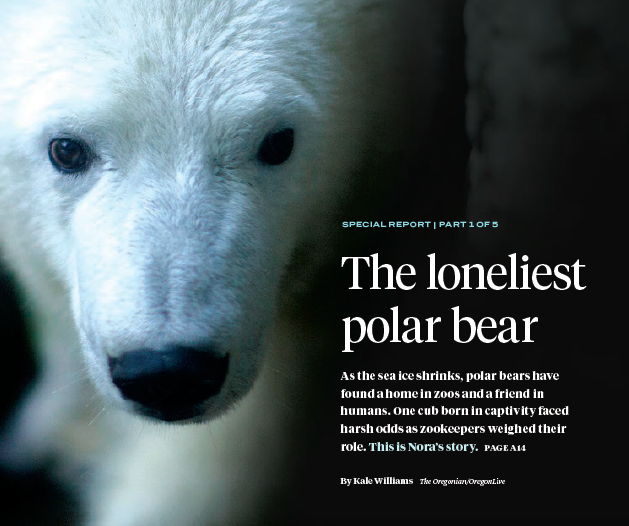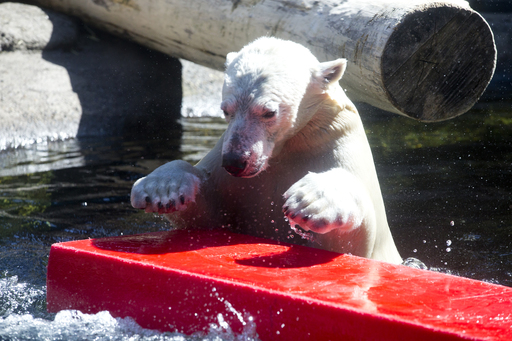
But there’s more.
“Project Nora,” as The Oregonian/Oregon Live called it, also featured a 30-minute documentary, “Thin Ice: A Polar Bear’s Plight.” A children’s book, “Hope for Nora,” debuted alongside coloring pages, a drawing contest, puzzles and a board game. In response to readers’ concerns for Nora, the newspaper ran several follow-up stories.
In other words: “The Loneliest Polar Bear” was a news tsunami.
“Project Nora,” published in October 2017 after a year of reporting, also took industry experts by storm: The print article won the Best Newspaper Narrative Writing contest hosted by the Mayborn Graduate Institute of Journalism at the University of North Texas; the online package won the top prize in the Online News Association Awards; a documentary film called “Thin Ice” by Dave Killen won two regional Emmys; and reporter Kale Williams won the AAAS Kavli Science Journalism Award and Edward J. Meeman Award for Environmental Reporting from by the Scripps Howard Foundation.
But this epic — which takes place across four states, in three zoos, and includes an injured Alaskan hunter, a weeping zoo keeper and a nutritionist who whips up batches of polar bear milk — illuminates issues of global warming and the somewhat discomfiting merits of zoos.
It all began with a seemingly simple story about a polar bear in Ohio moving to a zoo in Oregon.
The Oregonian’s package included a summary of its reporting approach in a “How We Did The Story” page. But that doesn’t go behind the scenes to explain the origins, decisions, collaborations and emotions involved in producing a package of this scope and intensity.
Storyboard reached out to some key members of the team of “Project Nora:” reporter Kale Williams, the Oregonians’ then-executive editor Mark Katches, Trending News editor Karly Imus, and narrative specialist, Kelley Benham French, who (via phone and email) addressed the process of writing this unforgettable story.
Kale Williams had been at the Oregonian for a little more than a year. As part of the Oregonian’s Trending team, part of his job was to scan the internet for popular topics, then develop them into stories for local readers. As part of that, he had a mini-beat focused on science and environment, and had written about wolves and polar bears.So when he saw a press release from the Oregon zoo announcing that a polar bear cub had just arrived from a zoo in Ohio, he took note. The cub had been abandoned by its mother, which, Williams knew, diminished its chances of survival. Williams met with Katches to discuss the idea of a larger narrative. But as Williams acknowledge in a recent phone interview, “I didn’t have the gumption to propose a 15,000-word story.”
Katches encouraged him to take the next step: “Why don’t you chase this a little bit more?”
So Williams phoned the Columbus Zoo in Ohio. He was connected with Devon Sabo, the keeper who had tended Nora’s mother, Aurora. As the cub’s backstory was filled in, Katches sensed more potential. He sent Williams to Ohio to interview Sabo in person.
About a decade earlier, Katches was in charge of projects at the Milwaukee Journal Sentinel. While there, he edited a three-part series about Mahal, an orangutan abandoned at birth. That story, written by Jan Uebelherr, won a 2009 National Headliner Award. “It was a lovely series, full of nice engagement touches — like a children’s book and coloring contest,” Katches wrote in an email.
Now along comes “this gorgeous bear.” Nora was 10 months old at this point, with an origin story that reminded Katches of the ill-fated baby orangutan. He saw an opportunity to “delve deeper into the cub’s life and to really understand the motivations of the people who saved her.” He also saw a compelling doorway into reporting on climate change, wildlife extinction and “the philosophical discussion about animals in captivity.”
As the story was in its early stages, Katches enlisted award-winning journalist Kelley Benham French, who now teaches at Indiana University and has worked as a consulting editor on other Oregonian projects. Benham French was a Pulitzer Prize finalist for “Never Let Go,” an intimate story about her own infant, who was born just shy of 24 weeks. She also lives with a menagerie of animals, and often fosters puppies.
Benham French helped shape the reporting and writing from afar as “Project Nora” grew. In-house, Oregonian editor Karly Imus pulled together the myriad multimedia elements that made up the full creative package. Together, Katches said, the four of them “ran the Milwaukee playbook — on steroids.”
Williams’ reporting from Ohio helped establish a timeline of what that zoo did on behalf of Nora’s survival — a timeline that plays out in pulse-quickening opening graphs of his story, describing how, when Nora was six days old, her mother “rose and stretched and ambled” out of the den, and failed to return. Nora, “unmoored from her mother’s gravity and heat,” began screeching “like a baby dragon.”In the past, most of Williams’ work involved filing short pieces on deadline: “I write a thing, get a quote, write a clever transition, then end with a quote.” But as this story grew beyond manageable bounds — “there’s a new creature at the Portland Zoo” — Williams felt his anxiety rise.
Williams was already familiar with Benham French, who had done a workshop and some other contract editing at The Oregonian. When Katches invited her to help with Project Nora, she instantly recognized the potential for “a riveting action-packed, nail-biter about the fight to save this baby bear.” Benham French told me by email that Nora was “the cutest, most engaging, most sympathetic character I’ve ever seen in my life.”
Benham French had intimate knowledge of high-stakes moments with infants because of her own daughter, who was born so prematurely — at 23 weeks — that her chances of survival were little more than a question mark for several months. Benham French chronicled her daughter’s story in a newspaper series for the Tampa Bay Times: “Never Let Go,” which was a finalist for the 2013 Pulitzer in feature writing. She then collaborated with her husband, Pulitzer Prize-winning reporter Tom French, on a book, “Juniper: The Girl Who Was Born Too Soon.”
To add to the connections, Tom French had written a seven-part series for the Tampa Bay Times — then the St. Petersburg Times — taking readers behind the scenes of the Lowry Park Zoo. That was expanded into a book, “Zoo Story: Life in the Garden of Captives.” When the story of Nora came her way, Benham French said, it was as if “‘Never Let Go’ and ‘Zoo Story’ had a baby.”
The parallels were stunning to Benham French. “Nora, the baby polar bear, and Juniper, the baby human, were the exact same size at birth (one pound),” she told me. “And both required groundbreaking interventions to survive.”
That knowledge helped Benham French guide Williams through a story that was emotional and descriptive as well as factual. Readers meet Nora when she’s just six days old, “the size of a squirrel, deaf and blind” with “translucent fur (that) barely covered her pink skin” and picture her “soft paws paddle(-ing) against the straw” as her nose leads her “in one direction: toward her mother.” A mother who, readers learn, will never return.With Benham French’s encouragement, Williams began to explore a greater context for the story and track down Nora’s ancestors. He traced Nora’s father back to zoos in Buffalo, New York, and Wisconsin, learning that the bear had been orphaned in Alaska in 1988. He requested U.S. Fish and Wildlife press releases from that year, and found a mention of Gene Rex Agnaboogok who, 27 years before Nora’s birth, literally stumbled upon the bear that eventually became Nora’s father.

Gene Rex Agnaboogok at home in Wales, Alaska, in 2017. In 1988, Agnaboogok shot a polar bear on a hunting trip, orphaning two cubs in the process. One of those cubs went on to father Nora, a polar bear born at the Columbus Zoo in Ohio and later transferred to the Oregon Zoo in Portland.
The press release listed Agnaboogok’s village, a tiny town called Wales. Williams reached out to see if he still lived there. Yes, he did. And he was happy to talk.
That’s the moment the story turned, according to Benham French. Beyond a compelling piece about the consequences of rearing wild animals in captivity, it now revealed connections to climate change and its effects on culture and traditions. The project team had been trying to find a climate scientist who studied the impact on Arctic bears, assuming that person would be in Canada. But when Williams found a native Alaskan who had fallen through the ice directly into a den and killed the angry polar bear and taken her cubs, a door opened directly to Nora’s story. And Nora’s story was a doorway to environmental changes in the Arctic.
“When we started, we did not know about Nora’s connection to the Alaskan wilderness, about the Eskimo who killed her grandmother, about the researcher working with her wild relatives,” said Benham French.
Katches, the top editor, jumped back in: “Let’s make it happen!” Williams was soon on his way to Alaska.
Initially the team thought the story could be told in one strong narrative. Then it became three chapters. Then five. The more they reported, the more they learned about the core risk posed by the cub’s abandonment, and about her physical and mental health issues.Benham French says, “All of that is a credit to Kale’s tireless, clear-eyed reporting. He could have just been gobsmacked by Nora’s cuteness or the already-amazing story in hand, but he didn’t stop. He got critically important zoo records that unveiled a much more complex story.”
Williams said drafting the first two chapters was intense. He would write; Benham French would shape. By the third chapter, Williams felt like he had absorbed some of techniques for this kind of writing. He applied Benham French’s oft-repeated advice: “Get out of your notebook.” Understanding that readers need a reason to care about the reporter’s cache of facts and quotes, he strove to put the facts of Nora’s story into a larger context.
Meanwhile, Benham French hounded him for specifics:
“I pushed Kale for details that existed initially only in my imagination. Like, what does a polar bear’s breath smell like? (While we don’t learn about bear breath in the published story, we know the den where Nora was born smelled of “cool concrete” and “captive musk.”) What gauge needle did veternarian Priya Bapodra use? (Answer: 22, the second smallest needle on hand.) I was fixated on a few things he probably thought were stupid.”
Williams learned to anticipate the directives: “More detail! More dialogue! More meaning!” He gathered minute details, like the fact that the newborn’s birth plan ran 23 pages, that the rifle that killed her grandmother was a .270 Remington, and that the device used to mix baby bear milk replacer was a “Magic Bullet.”
Williams and Benham French poured the information into shared Google docs. They chopped three long sections into five shorter ones. They moved sections from one chapter to another.
Mark Katches was also hands-on. And Williams’ regular editor, Karly Imus, was closely involved, not only with the story but with the many other elements of the multimedia package.
In September 2017, Katches called Benham French to say he was moving the publication date up, from December to October. At that point, only two parts were written. Benham French had just started a new teaching semester at Indiana. She took the call while standing on her front porch in Bloomington: “I had to sit down. I told (Katches), ‘I’m going to need a lot of chocolate.’ A few days later, two pounds of See’s Candy arrived in the mail.
In addition to unspooling an extraordinary narrative, “The Loneliest Polar Bear” works throughout to serve larger themes and issues. Every sentence either builds to or supplies an answer to an essential question: Why does this matter? Benham French said that was a running push from her husband as they worked together on “Juniper,” and from Mike Wilson, her longtime editor in St. Petersburg, and now editor of the Dallas Morning News. It now infuses her writing, editing and teaching.“As is true in nearly every story I work on, with college students and with Pulitzer winners, I take responsibility for the big ideas,” she said. “The reporter is buried in logistics and details and facts, so the editor is a little more free to see the story from a higher altitude and riff on What It All Means. Many of the sections where you see a lot of synthesis and voice are my influence.”
She means passages like:
Nora was the first newborn polar bear to live more than a few days at the Columbus Zoo and Aquarium since it opened in 1927. Her birth in a concrete den in central Ohio represented all the ways humans and polar bears were inextricably tangled—from the day nearly three decades before when an orphaned cub was pulled from an icy den in the Alaskan wilderness, to the political battle that appointed her species the sad-eyed symbol of climate change. She represented the damage humans had done to the Earth, and she offered the thinnest hope of setting things right.
And:
Nora had a role to play. She could grow up and contribute to the biodiversity of the species. She could help scientists understand her distant cousins who still walked the shrinking Arctic ice where her father was born. She could endear herself to millions of visitors who might think of her when they filled their gas tanks or tuned into the latest political debate.
And:
Nora could lead a generation of children to consider their role in preserving the planet.

Nora's last day at the Oregon Zoo in September 10, 2017. Nora was sent to Hogle Zoo in Salt Lake City, Utah.
During the first six weeks it received nearly 200,000 unique visitors and more than 1.2 million video views. According to Oregonian metrics, viewers spent an average of 20 minutes online with the story, which Williams said is “an eternity.”
During the weeks leading up to publication, as the Project Nora team struggled to contain the sprawling narrative, The Oregon Zoo announced Nora would be leaving Portland for Utah’s Hogle Zoo in Salt Lake City and be in quarantine at her new home in when the series ran. The story had no neat ending. Katches advised writing an ending that was unresolved, which would also make the story feel current, so Williams reported and wrote Part Five almost live.
And there wasn’t just the written narrative to get right. Karly Imus was charged with pulling everything together inside The Oregonian newsroom, coordinating the work of a dozen staffers and freelancers. With so many moving parts, including filming documentary and illustrating a children’s book, Project Nora had become all-consuming, she said.
As publication deadline loomed, Imus handed off most of her other duties to another editor so she could give it 100 percent focus. She brought her kids to the office on weekends. She edited by reading drafts aloud to her son. All told, the story went through more than 30 drafts. Benham French flew to Oregon so the four primary team members — Williams, Benham French, Imus and Katches — could read all five parts aloud, which they did over the course of two days.
Imus testified to the pride she felt about the collaborative process and project’s success: “We’re a talented, scrappy newsroom and we aren’t afraid to throw resources at good journalism. I think a project of this scope, where we had so many staffers working on aspects of it, shows what can happen when you believe in a story and commit to it.”
Benham-French echoes the sentiment: “I’ve never worked on a project that involved so many people and so few meltdowns. It was all just a joy, beginning to end. I’m still sad that it’s over.”
And yet: the narrative continues. The Oregonian ran a follow-up story in late 2017 on how Nora was adjusting to the Utah zoo. Then in February of 2019, Nora broke her leg. An article in March chronicled Nora’s new friend, Hope. Meanwhile, Kale Williams is working on a book about Nora due out sometime in 2021.The success of the Project Nora has inspired The Oregonian to mount other ambitious multimedia news projects. Applying the lessons from the Loneliest Polar Bear, the newspaper used insights–from timelines to design to social media roll-out of related content —to guide the launch of “Guns: An American Conversation,” which aired in the spring of 2018 and was the focus of a Storyboard feature; “The Ghosts of Highway 20,” which debuted in December 2018; and “Polluted by Money.” which launched in March 2019.


